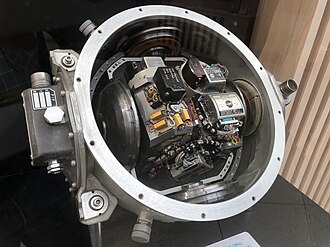Inertial navigation system





Inertial Navigation System (INS) is a navigation technology that uses a computer, motion sensors (accelerometers), and rotation sensors (gyroscopes) to continuously calculate by dead reckoning the position, orientation, and velocity (direction and speed of movement) of a moving object without the need for external references. Unlike other navigation systems such as GPS (Global Positioning System), which rely on external signals, an INS is self-contained and can be used in environments where GPS signals are unavailable.
Overview[edit]
The principle behind an INS is to measure the acceleration and angular velocity of the vehicle in which it is installed. By integrating acceleration data over time, the INS can calculate velocity, and by further integrating velocity, it can determine position. Angular velocity measurements allow the INS to track the orientation of the vehicle. This process of calculation is known as dead reckoning.
Components[edit]
The main components of an INS include:
- Accelerometers: Sensors that measure acceleration along one or more axes.
- Gyroscopes: Sensors that measure the rate of rotation around one or more axes.
- Computational Unit: A computer that processes data from the accelerometers and gyroscopes to calculate position, orientation, and velocity.
Operation[edit]
The operation of an INS involves several steps:
1. Initialization: The INS is initialized with the known starting position, orientation, and velocity of the vehicle. 2. Sensing: The accelerometers and gyroscopes continuously measure the vehicle's acceleration and angular velocity. 3. Computation: The computational unit integrates the acceleration to calculate velocity and integrates velocity to calculate position. It also computes the orientation of the vehicle using data from the gyroscopes. 4. Correction: Some INS systems include mechanisms for error correction, as errors can accumulate over time due to drift in the sensors.
Applications[edit]
INS technology is used in a variety of applications, including:
- Aircraft navigation
- Ship navigation
- Submarine navigation
- Spacecraft navigation
- Missile guidance
- Robotics
- Surveying
Advantages and Disadvantages[edit]
Advantages of INS include:
- Functionality in environments where external signals (like GPS) are not available.
- High initial accuracy.
- Complete autonomy and independence from external signals.
Disadvantages include:
- Sensor errors accumulate over time, leading to drift.
- High cost and complexity compared to some other navigation systems.
- Requires periodic recalibration or external correction to maintain accuracy.
Future Developments[edit]
Advancements in sensor technology and computational methods continue to improve the accuracy, reliability, and cost-effectiveness of INS. Integration with other navigation systems, such as GPS, is common to mitigate the limitations of each system.
Ad. Transform your life with W8MD's Budget GLP-1 injections from $75


W8MD offers a medical weight loss program to lose weight in Philadelphia. Our physician-supervised medical weight loss provides:
- Weight loss injections in NYC (generic and brand names):
- Zepbound / Mounjaro, Wegovy / Ozempic, Saxenda
- Most insurances accepted or discounted self-pay rates. We will obtain insurance prior authorizations if needed.
- Generic GLP1 weight loss injections from $75 for the starting dose.
- Also offer prescription weight loss medications including Phentermine, Qsymia, Diethylpropion, Contrave etc.
NYC weight loss doctor appointmentsNYC weight loss doctor appointments
Start your NYC weight loss journey today at our NYC medical weight loss and Philadelphia medical weight loss clinics.
- Call 718-946-5500 to lose weight in NYC or for medical weight loss in Philadelphia 215-676-2334.
- Tags:NYC medical weight loss, Philadelphia lose weight Zepbound NYC, Budget GLP1 weight loss injections, Wegovy Philadelphia, Wegovy NYC, Philadelphia medical weight loss, Brookly weight loss and Wegovy NYC
|
WikiMD's Wellness Encyclopedia |
| Let Food Be Thy Medicine Medicine Thy Food - Hippocrates |
Medical Disclaimer: WikiMD is not a substitute for professional medical advice. The information on WikiMD is provided as an information resource only, may be incorrect, outdated or misleading, and is not to be used or relied on for any diagnostic or treatment purposes. Please consult your health care provider before making any healthcare decisions or for guidance about a specific medical condition. WikiMD expressly disclaims responsibility, and shall have no liability, for any damages, loss, injury, or liability whatsoever suffered as a result of your reliance on the information contained in this site. By visiting this site you agree to the foregoing terms and conditions, which may from time to time be changed or supplemented by WikiMD. If you do not agree to the foregoing terms and conditions, you should not enter or use this site. See full disclaimer.
Credits:Most images are courtesy of Wikimedia commons, and templates, categories Wikipedia, licensed under CC BY SA or similar.
Translate this page: - East Asian
中文,
日本,
한국어,
South Asian
हिन्दी,
தமிழ்,
తెలుగు,
Urdu,
ಕನ್ನಡ,
Southeast Asian
Indonesian,
Vietnamese,
Thai,
မြန်မာဘာသာ,
বাংলা
European
español,
Deutsch,
français,
Greek,
português do Brasil,
polski,
română,
русский,
Nederlands,
norsk,
svenska,
suomi,
Italian
Middle Eastern & African
عربى,
Turkish,
Persian,
Hebrew,
Afrikaans,
isiZulu,
Kiswahili,
Other
Bulgarian,
Hungarian,
Czech,
Swedish,
മലയാളം,
मराठी,
ਪੰਜਾਬੀ,
ગુજરાતી,
Portuguese,
Ukrainian
